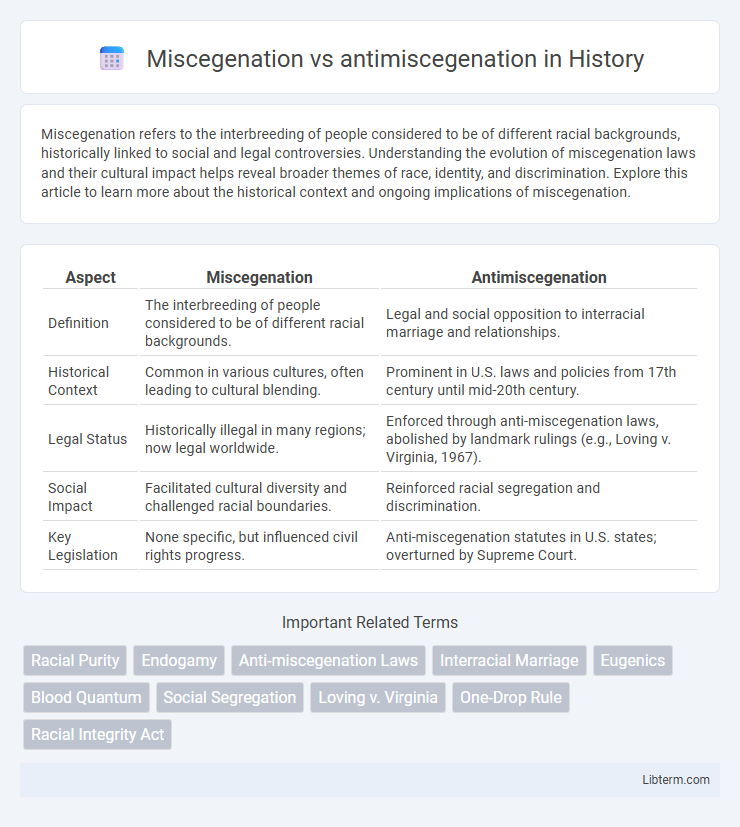Miscegenation refers to the interbreeding of people considered to be of different racial backgrounds, historically linked to social and legal controversies. Understanding the evolution of miscegenation laws and their cultural impact helps reveal broader themes of race, identity, and discrimination. Explore this article to learn more about the historical context and ongoing implications of miscegenation.
Table of Comparison
| Aspect | Miscegenation | Antimiscegenation |
|---|---|---|
| Definition | The interbreeding of people considered to be of different racial backgrounds. | Legal and social opposition to interracial marriage and relationships. |
| Historical Context | Common in various cultures, often leading to cultural blending. | Prominent in U.S. laws and policies from 17th century until mid-20th century. |
| Legal Status | Historically illegal in many regions; now legal worldwide. | Enforced through anti-miscegenation laws, abolished by landmark rulings (e.g., Loving v. Virginia, 1967). |
| Social Impact | Facilitated cultural diversity and challenged racial boundaries. | Reinforced racial segregation and discrimination. |
| Key Legislation | None specific, but influenced civil rights progress. | Anti-miscegenation statutes in U.S. states; overturned by Supreme Court. |
Understanding Miscegenation: Definition and Historical Context
Miscegenation refers to the interbreeding of people considered to be of different racial backgrounds, historically viewed through various social and legal lenses. Understanding its definition involves recognizing the complex interactions of race, culture, and identity that influenced societies, particularly in the Americas during and after the colonial era. The historical context highlights how miscegenation became a significant point of contention, leading to the establishment of antimiscegenation laws aimed at prohibiting interracial marriages and relationships to maintain racial hierarchies.
The Roots of Antimiscegenation: Ideologies and Motivations
Antimiscegenation, rooted in racist and segregationist ideologies, emerged to preserve perceived racial purity and maintain social hierarchies. These motivations were fueled by pseudoscientific beliefs in racial superiority and fear of cultural dilution, driving laws and social practices that prohibited interracial relationships. The enforcement of antimiscegenation laws reflected broader efforts to control African American populations and reinforce white dominance in society.
Laws and Policies: Key Moments in Miscegenation and Antimiscegenation History
Miscegenation laws, codified in the 17th century and persisting into the 20th century, prohibited interracial marriages and relationships, with the U.S. Supreme Court's 1883 rulings and the pivotal 1967 Loving v. Virginia decision marking crucial turning points in their enforcement and abolition. Antimiscegenation policies were enforced through legal systems in various countries, often justified by racial purity doctrines aiming to maintain social hierarchies and segregation. The dismantling of these laws reflects significant shifts in civil rights, with international human rights movements condemning racial discrimination embedded in marriage restrictions.
Social Impact: Effects on Families and Communities
Miscegenation laws affected families by legally prohibiting interracial marriages, leading to social stigmatization and fractured relationships within communities. Antimiscegenation enforcement reinforced racial segregation, perpetuating systemic inequality and limiting social mobility for marginalized groups. These policies created long-lasting psychological and social trauma, destabilizing family structures and hindering community cohesion.
Miscegenation in Popular Culture and Media Representations
Miscegenation in popular culture often serves as a powerful narrative tool challenging social norms and highlighting racial integration through films, television shows, and literature that depict interracial relationships. Media representations frequently explore themes of identity, acceptance, and resistance against societal prejudices, reflecting evolving attitudes toward racial diversity. Positive portrayals of miscegenation contribute to normalizing multicultural connections and fostering dialogue about racial equality and inclusion.
Antimiscegenation Movements: Past and Present
Antimiscegenation movements, historically rooted in racist ideologies, aimed to prohibit interracial marriages and relationships through laws such as the 1883 US Supreme Court ruling in Pace v. Alabama and numerous state statutes until the 1967 Loving v. Virginia case invalidated these laws nationwide. In contemporary contexts, remnants of antimiscegenation persist in social and political spheres, often manifesting in nationalist and ethnonationalist groups that oppose racial integration and promote segregationist rhetoric. Despite legal abolishment, these movements continue to influence discussions on race, identity, and marriage equality in various countries.
Legal Battles: Landmark Court Cases on Interracial Marriage
Legal battles surrounding miscegenation and antimiscegenation laws reached a pivotal moment with the 1967 Supreme Court case Loving v. Virginia, which struck down state laws banning interracial marriage as unconstitutional under the Fourteenth Amendment. Prior to this ruling, numerous states enforced antimiscegenation statutes that criminalized marriages between individuals of different races, often resulting in legal penalties and social discrimination. The Loving case set a precedent that invalidated all such laws across the United States, affirming the fundamental right to marry regardless of race and catalyzing further civil rights advancements in marriage equality.
The Role of Science in the Miscegenation Debate
Scientific theories played a pivotal role in shaping the miscegenation debate by providing purported biological justifications both for and against interracial marriage. Early racial science promoted ideas of racial hierarchy and genetic differences that fueled antimiscegenation laws designed to prevent mixing of races. Contemporary genetics has debunked these myths, emphasizing shared human ancestry and the social construction of race, yet science's historical involvement continues to influence societal attitudes toward miscegenation.
Changing Attitudes: Shifts in Public Perception Over Time
Public perception of miscegenation has evolved significantly, with increasing acceptance of interracial relationships due to growing awareness of diversity and civil rights advancements. Antimiscegenation laws, once widespread, have been largely abolished following landmark rulings like Loving v. Virginia (1967), reflecting a shift toward equality and social integration. Contemporary attitudes show greater societal support for interracial unions, highlighting the ongoing decline of racial prejudices tied to miscegenation.
Contemporary Issues: Miscegenation and Antimiscegenation in Today’s Society
Contemporary issues surrounding miscegenation and antimiscegenation involve ongoing debates about racial identity, social integration, and systemic discrimination. Despite legal advances, interracial couples often face societal prejudices and institutional biases that reflect deep-seated antiracist tensions. The discourse highlights challenges in achieving genuine equality and social acceptance within increasingly diverse societies.
Miscegenation Infographic

 libterm.com
libterm.com